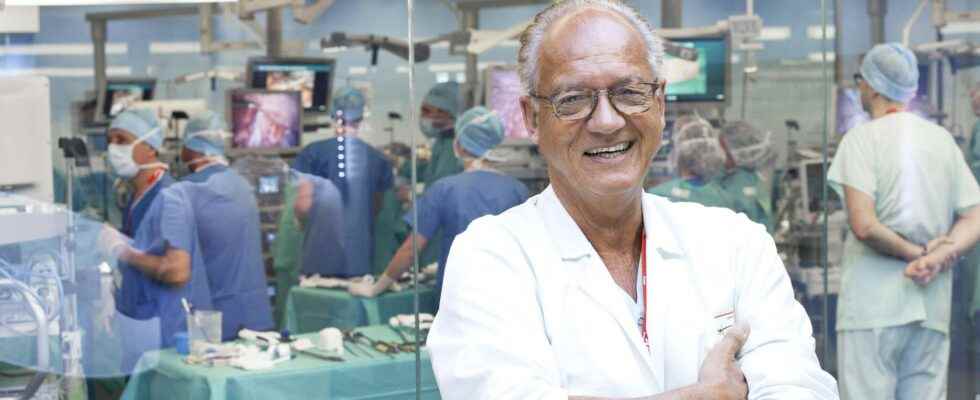Scanners and MRIs, which cost several million euros each, are often inaccessible to developing countries. IRCAD, known worldwide in surgical robotics, is working on a low-cost ultrasound machine capable of automatically detecting and then treating tumors before they develop. A major breakthrough made possible thanks to the extraordinary growth of artificial intelligence, tells us Jacques Marescaux, president of IRCAD.
You will also be interested
In 2001, “Operation Lindbergh” carried out by Professor Jacques Marescaux had the effect of thunder in the world of surgery. For the first time, a patient located in Strasbourg was operated remotely from New York using a robotic console. Since the robot surgeons have developed a lot, but still remain limited in terms of possibilities. Another revolution that appeared a few years ago in health could turn everything upside down:artificial intelligence. Jacques Marescaux, the president of IRCAD in Strasbourg, tells us how he uses AI to develop a low-cost ultrasound capable of detecting and operating on tumors before they get bigger. The project, named Disrumpere, promises an unprecedented democratization of medical imaging.
Why did you seek to develop a low-cost ultrasound system?
In 2021, I came across a WHO report that indicated that 5 billion people did not have access to any medical imaging. Then I saw another study showing that 5.8 billion people did not have access to basic surgery. Here at IRCAD, we work with cutting edge tools that cost several million euros. But in many countries, hospitals cannot afford to pay for MRI or a scanner over a million euros. By comparing, ultrasound has many advantages: it does not require a source ofenergy and can be plugged in anywhere. In recent years, low-cost probes have appeared (around 400 to 500 euros). They are therefore ideal tools for developing low-cost medical imaging.
What exactly can these low cost ultrasound scanners do?
Of course, the image with such a probe is not as good as with a 100,000 euro ultrasound machine like the ones we use in the hospital. But this is where artificial intelligence comes into play: our machine, which has trained on thousands of ultrasounds, will transform a 2D image in black and white into a 3D image in color much more precise. We are thus able to detect tumors smaller than 2 cm in diameter, that is to say at a stage where they can be destroyed without major surgery. AI can also tell if the organ has been fully scanned, so you don’t miss a tumor.
How is this artificial intelligence integrated into robotics?
When the tumor is still at an early stage, it can be destroyed without performing a complex operation, which as I said is not accessible to everyone. Percutaneous destruction is practiced, which consists of inserting a needle into the center of the tumor by heat (radiofrequency) or by cold (cryoablation). The problem is that you have to be extremely precise to position the needle correctly. THE’automaton guided by artificial intelligence will place the needle in the right place, say how deep it must be inserted, and all that is needed is to validate the machine’s proposal to practice the gesture. We are working with the startup for this Axilum Robotics, who developed low cost robotic arms.
Can we imagine a fully automated surgical operation tomorrow?
Absolutely. Tomorrow we will have robots autonomous surgical procedures in the same way as autonomous cars. Moreover, we could already perform the surgical procedure automatically, but very complex homogations are needed to allow a machine to pierce the skin with a needle! Today, we are only in the prehistoric era in matter of robotic surgical, which is used primarily to accompany the surgeon’s gesture. With the addition of artificial intelligence, the robot is able to precisely reproduce the gestures it has learned over thousands of hours of operation video. The surgeon will virtually “operate” on clones digital, then the algorithm will retain the best possible procedure to practice a perfect gesture. In the future, the one who will win the robotic surgery competition is the one who will put the most AI in his system!
Isn’t this robotic medicine going to be reserved for an elite?
On the contrary ! As the example of our Disrumpere project shows, AI can be used to democratize access to health in developing countries. Even with us, it could revolutionize disease diagnosis. Today, a whole battery of exams (MRI, scanners…) which are very expensive just as prevention. If tomorrow AI makes it possible to make such a reliable diagnosis with tools that are 100 times cheaper, everyone is a winner.
Interested in what you just read?
.
fs6
